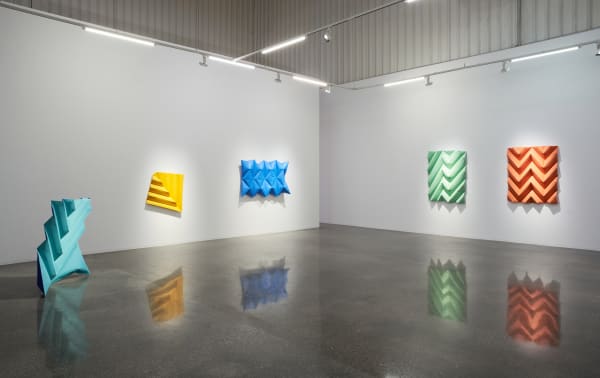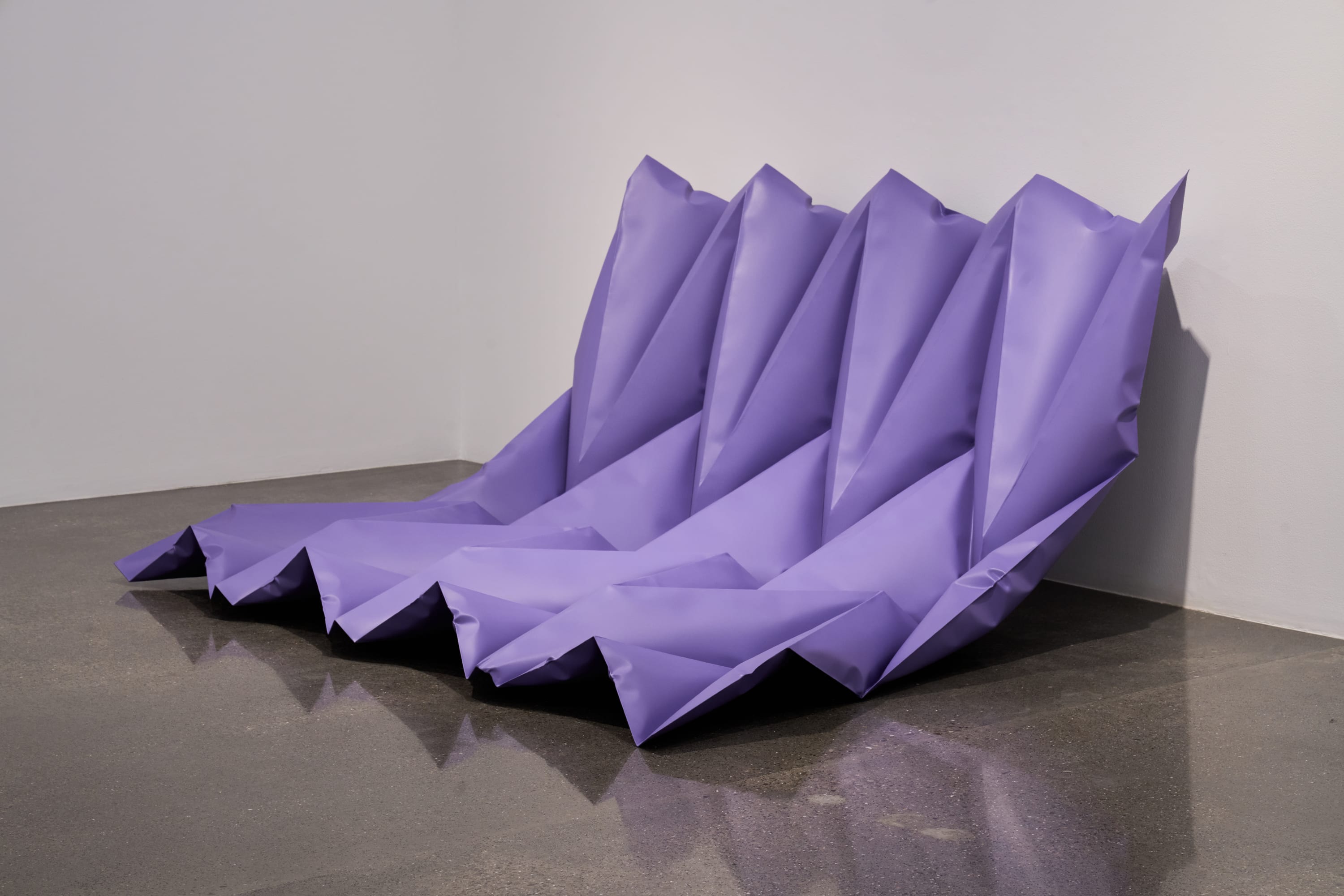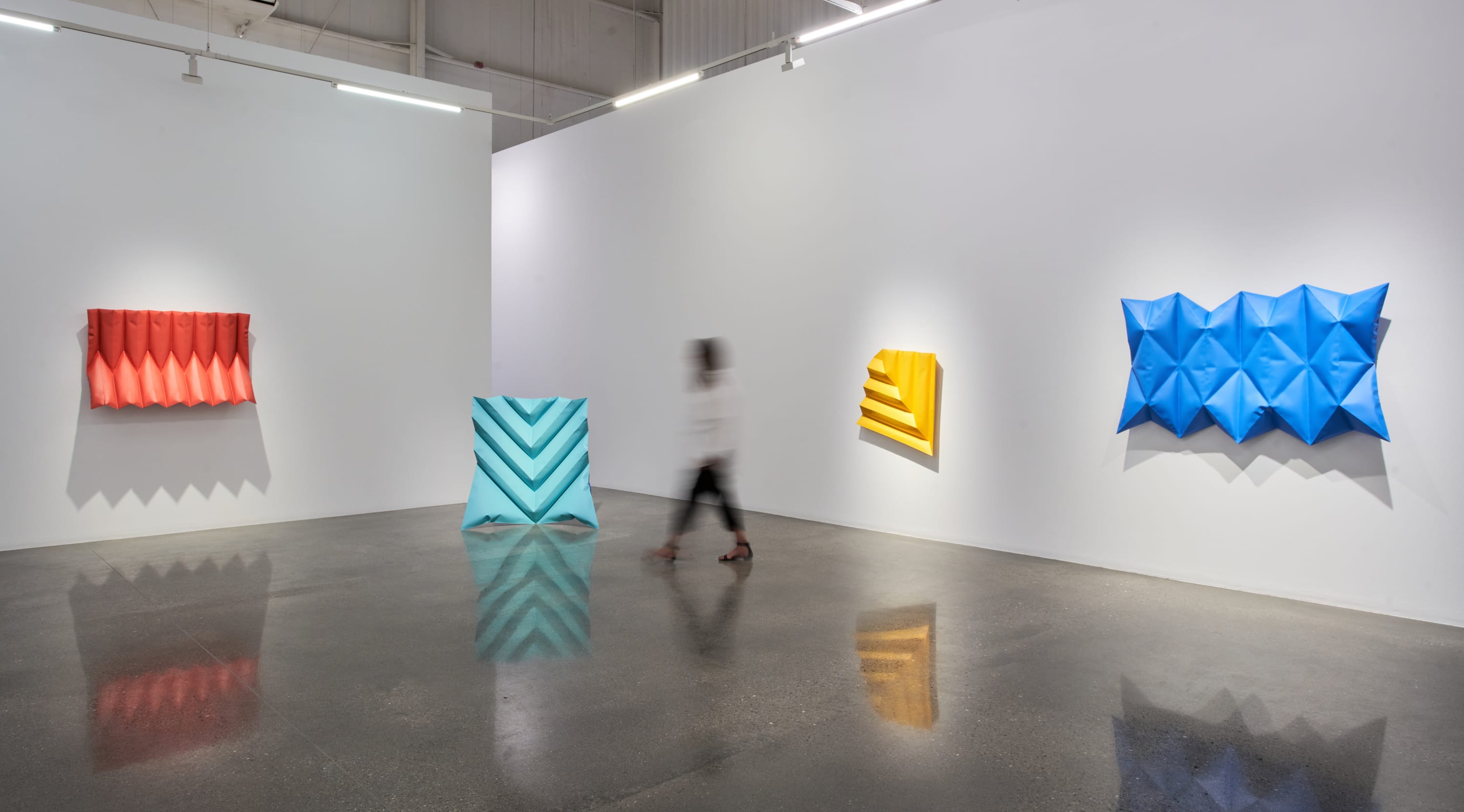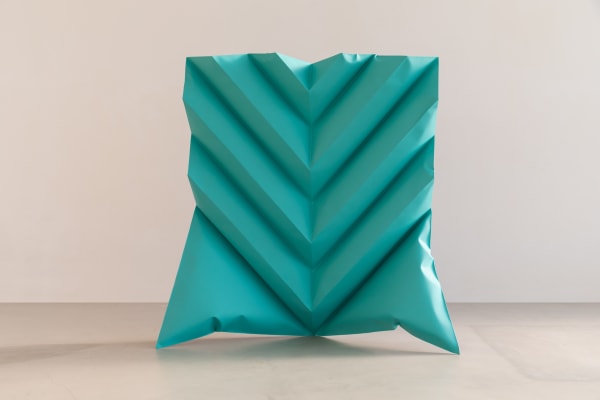-

Dwelling in the Gap is Shaikha Al Mazrou's second solo exhibition at Lawrie Shabibi. Here Al Mazrou develops the forms and language of her practice, and extends her investigations into materiality, tension and the interplay between structure and content. Her materials appear to betray their functions and their fixed properties. This space of ambiguity - between the intent of the artist and the possibilities of her materials – results in the gap that is central to her creative process.
-
Al Mazrou’s new sculptures are partially inspired by the properties and possibilities of folded and creased paper, transmuted into stainless steel. Inflated and folded, they resemble giant displays of origami, the shapes of which are drawn from small-scale paper prototypes created by the artist. Finished in vibrant blocks of colour, which range from her signature red, together with yellow, orange, blue and teal, the works embody characteristics that are simultaneously organic and synthetic.Complementing these steel sculptures are Irrational Figures, a new series of ten works, laser-cut laminated wood grained structural forms laid down on paper. The structures twist themselves together, interlocking, turning like mazes, some in eternal knots. The gap between their seeming solidity and their actual flatness, results in unresolvable tensions.
-
Dwelling in the Gap
Essay by Terri GeisShaikha Al Mazrou’s work dwells and drifts in the spaces between substance, transmutation, and deception. In her recent sculptures and works on paper, materials appear to betray their functions and their fixed properties, shapes and angles connect and then release into mysteries. We are left to wonder: what is the precise point in which one thing becomes something else? Is it even possible to know? In these artworks, are we looking at paper or steel, folds or welded fragments? Al Mazrou pushes her materials to see what they will yield, but ultimately must also listen to their message and possibly even accept their secrecy. It is in this space of uncertainty and communion—between artist and material, between artwork and viewer—that we find what Marcel Duchamp described as “the gap” that is central to the creative act:
[…] the artist goes from intention to realization through a chain of totally subjective reactions. Their struggle toward the realization is a series of efforts, pains, satisfaction, refusals, decisions, which also cannot and must not be fully self-conscious, at least on the esthetic plane. […] in the chain of reactions accompanying the creative act, a link is missing. This gap, representing the inability of the artist to express fully their intention, this difference between what they intended to realize and did realize, is the personal “art coefficient” contained in the work (“The Creative Act” 139).
If this gap of creation is the art coefficient, for Al Mazrou the variable is found in the industrial zones throughout the Emirates that she has long frequented, spaces of machines spinning, grinding, and forming the materials for construction, spaces of sample books and scattered remnants. In these places, she locates the raw materials that will allow her to start anew, through laser cutting, welding, gluing, hammering, coating. This process entails a combination of chance encounter and rigorous labor, a balance that Al Mazrou reinforces through intuitive application of color, texture, and finish. And as a counter to these commercial and constantly evolving spaces of fabrication, Al Mazrou also notes a transformative visit to the materials archive of the Kunstgiesserei/Sitterwerk in St. Gallen, Switzerland. This interactive laboratory houses a large collection of specimens in stone, plastic, wax, bronze, and more. From here, one can attempt to understand materials both natural and synthetic—what lies at the heart of them? As Al Mazrou tells me about the archive, her descriptions and reactions to its seemingly endless potentials begin to remind me of Jorge Luis Borges’ short story, The Library of Babel (1941), in which the narrator details a library that is a universe formed of interlocking hexagonal rooms filled with every book ever written, or that ever will be written. These mirrored, endless galleries offer the “figuration and promise of the infinite” (112).
-
Yet—as The Tower of Babel explores—even the things that we ourselves have made can’t be fully understood, grasped, or sometimes even found. Al Mazrou’s newest sculptures are partially inspired by the properties and possibilities of folded and creased paper, transmuted into stainless steel. She texts me a photo of an A4 sheet of paper, intricately folded and cut as a prototype for a sculpture, and writes (invoking the Duchampian gap), “It’s so complex! The angles are driving me insane!” I look at this paper model, floating, shadowing, zigzagging on the table, and see the folds that Gilles Deleuze describes as “the mountains and the waters, papers, fabrics, living tissues, the brain” (“The Fold” 242). It is the Baroque fold that goes on to infinity, adding more and more and more; it is a labyrinth that doubles back upon itself; knowing Al Mazrou’s strong interest in the aesthetics of Japan, it is also an ephemeral paper streamer hung on a Shinto shrine. And it is furthermore a deterioration or breakage; for Deleuze, the fold is also about the tensions of opposing directions, it is “perhaps at its limit that texture is best revealed, just before rupture or tearing” (245). Where does one side of the fold end and the other begin? Does it cease to be a fold if it breaks in half? If we are addressing a haptic crease, then why is it that we might best reflect on these questions of ambiguity and change when looking at Al Mazrou’s sculpture that falsifies the paper fold/crease through laser-cutting and then welding (re-joining) a sheet of steel?
-

-
 Shaikha Al Mazrou, Close To The Coast But Not Too Close, 2020, Hand painted sand, Approx. 100 cm in diameter, Approx. 39 3/8 in diameter, Courtesy of the artist and Lawrie Shabibi.
Shaikha Al Mazrou, Close To The Coast But Not Too Close, 2020, Hand painted sand, Approx. 100 cm in diameter, Approx. 39 3/8 in diameter, Courtesy of the artist and Lawrie Shabibi. -
With this tension we are back to the Duchampian gap, an indefinable space that he also expresses with his concept of the infra-thin, “the most minute of intervals, or the slightest of differences” (Note 4). Duchamp’s examples take the form of notes that were published posthumously; minute intervals include the warmth of a seat that has just been vacated, while slight differences include two mass-produced objects created from the same mold. As Duchamp explains, “The possible, implying the becoming—the passage from one to the other takes place in the infra-thin” (Note 1). If Al Mazrou’s paper works result from a labor-intensive process of puzzling, fitting, and connecting wood grains to create a possibility that is actually a deception, the result recalls another Duchampian infra-thin: “Reflections — on certain woods / light playing on / surfaces. Infra-thin brought about / by the perspective” (Note 42). And this aspect is also present in some of Al Mazrou’s previous projects, such as her installation created for the Jameel Art Centre in 2018, Green house: Interior yet Exterior, Manmade yet Natural, where six green glass forms reveal and conceal their interiors, reflect through each other yet do not connect, offer a verdant reference to nature yet grow nothing. A more recent example is offered in the two highly polished, reflective copper floor pieces that comprise We Met Halfway (2020), which Al Mazrou describes as “Two non-identical forms, a moment where the difference is collapsed” (“Rearranging the Riddle” 118). With her new sculptures and works on paper, Al Mazrou explains that they both result from a similar action of laser-cutting and piecing shapes together. Yet they also contain opposing systems of compression and expansion: the works on paper utilize laminates that result from flattening together multiple layers, while the sculptures ultimately result from a process of air pumped into the steel. And if the works on paper result solely from the imagination, the fabrication of the sculptures is only made possible through reference to their A4 paper prototypes. As I examine their beautiful turns and interlocking folds, I find myself making notes of the variations, the repetitions:
Note 1: An asymmetrical, vividly yellow form that rebels and pulls away from its own responsibility to gravity, pointing down to the ground but endlessly reaching up.
_
Note 2: A long blue form that most fully realizes the rounded, yet vulnerably taut surfaces possible when paper is folded and then unfolded within certain shapes of origami.
_
Note 3: Here is what happens when a form reaches its goal of cascading onto the floor to complete itself with deep, triangular shadows.
-
As this latter work descends its way to the ground, the folds and points become most extreme, interdependent, and mysteriously cavernous, invoking Deleuze:
'Always a fold within the fold, like a cavern within the cavern. The unit of matter, the smallest element of the labyrinth, is the fold, not the point, which is never a part, but only an extremity of the line. That is why the parts of matter are masses or aggregates, as corollary to the compressive elastic force. The unfold is thus not the opposite of the fold but follows one fold until the next (231).'
Through the intermingling of flat and rounded surfaces, rising and descending folds, and empty spaces, Al Mazrou gives us an art of becoming. As we join her in the gap, we enter into connection with playful mysteries, and then emerge with our own possible re-formings.
_
Terri Geis is an art historian and independent curator who is currently Visiting Associate Professor of Art and Art History at New York University Abu Dhabi.
-
William Lawrie, Director of Lawrie Shabibi, presenting ‘Dwelling in the Gap’ by Shaikha Al Mazrou, on view through 5 January 2023. Courtesy of Alserkal, the artist and Lawrie Shabibi.
Shaikha Al Mazrou: Dwelling in the Gap
Past viewing_room













